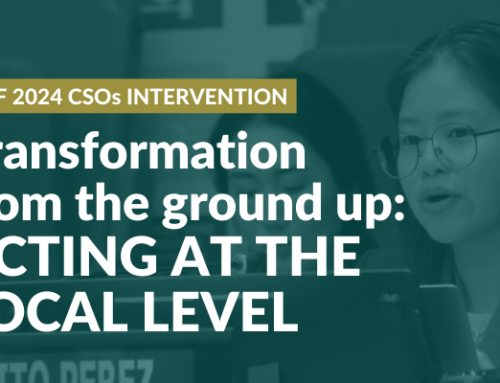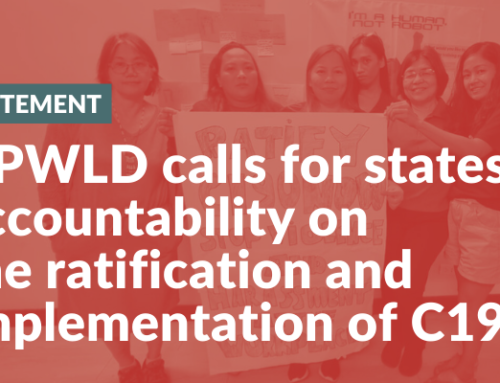Side Event at the 66th Session of Commission on the Status of Women (CSW66) | 15 March 2022, 7:00 PM ICT
Asia Pacific Forum on Women, Law and Development (APWLD), together with Fiji Women’s Rights Movement, the African Women’s Development and Communication Network (FEMNET), UN Women, Sida and the Permanent Mission of Mexico, held a side event at the 66th Session of the Commission on the Status of Women (CSW) to take stock of and analyse the gendered impact of losses and damages caused by climate crises particularly in Asia and the Pacific, Africa, and Latin America regions and to provide concrete policy recommendations for a human rights-based and gender just approach towards mitigation of and compensation for loss and damages and disaster risk responses.
The side event featured Nalini Singh, Executive Director, Fiji Women’s Rights Movement; Sara Duerto Valero, Regional Gender Statistics Specialist, UN Women Regional Office for Asia and the Pacific; Dr Christopher Ballinas Valdés, Director General for Human Rights and Democracy at the Undersecretariat of Multilateral Affairs & Human Rights, Mexico; Dr. Melania Choponda from the African Women’s Development and Communication Network (FEMNET); Lotta Sylwander, Lead Policy Specialist Gender, Swedish International Development Cooperation Agency (Sida); and Wanun Permpibul of Climate Watch Thailand. The discussion was moderated by Misun Woo, Regional Coordinator, Asia Pacific Forum on Women, Law and Development (APWLD).
Speakers at the side event highlighted that climate change is an issue of justice and that there is a need to recognise that the climate catastrophe is a result of historical injustices between rich nations that created the problem, and poor nations facing its heaviest impacts. Loss and damage caused by the climate crisis are part of the everyday realities of women and their communities. These include sinking islands due to increasing sea levels, forced migration and displacement due to climate-induced disasters, increase in non-arable lands and salinisation, and the resulting adverse impacts on indigenous communities, their cultures and distinct identity.
“[Women from the Global South] have least contributed to the climate crisis, but are most adversely affected and are holding tight the line to protect our communities and the planet from the already advancing climate catastrophe.” – Misun Woo, APWLD
Nalini Singh, FWRM, highlighted that Pacific Islands are increasingly being recognised as one of the most vulnerable areas to climate change, and Pacific Islanders are experiencing climate-induced losses and damages in profound ways. The region has already seen an increase in category 5 cyclones, droughts, tsunamis and heavy rainfall. Intolerable risks have become more apparent, such as massive relocation and resettlement, and the loss of crops, species and traditional practices. Recent studies have predicted that there would be a mass migration from the region by 2040.
The non-economic dimensions of loss and damages tend to be overlooked because they are often less tangible and difficult to measure. A study has shown eight interlinked dimensions, such as in the areas of health and well-being, cultures, way of life, biodiversity, social cohesion and other values that are not commonly traded in the markets. If left unaddressed, they can lead to the irreversible destruction of entire cultures and societies.
“Women are at the centre of these losses – as custodians of culture and tradition, as educators in the communities, as nurturers, providers, and as first responders. And once lost, these non-economic values cannot be compensated” –Nalini Singh, FWRM
Yet –Nalini emphasised –women are being left out of decision making tables, including climate change discussions and decisions. She foregrounded the need for concerted efforts around gender mainstreaming and recognizing non-economic losses and damages. These efforts should go beyond symbolic actions like putting up a desk; rather, these processes need to be transformative and integrative. Government agencies need to stop working in silos in order to address the losses and damages that cut across different issues.
Sara Duerto Valero of UN Women – Asia and the Pacific noted that “existing indicators and measures to assess the climate situation are not fit-for-purpose from a gender perspective.” One way to fill in gender data gaps is through data collection, she emphasised. Sara shared UN Women, FAO, ILO, IUCN, SPC, UNEP, UNDRR and UNESCAP’s efforts to develop the Model Questionnaire: Measuring the nexus between gender and environment, which includes 10 modules covering all areas relating to gender and climate change. The survey has already been piloted by several countries, such as Mongolia and Bangladesh.
“Another way to address gender data gaps is through data integration,” she noted. She shared that UN Women has done this by integrating geo-spatial information with survey data and have observed that a lot of climate-related variables (e.g. drought episodes, flood risk, aridity index) are highly correlated with a number of gender related outcomes (child marriage, adolescent births, intimate partner violence). Sample data from this methodology have been collated in UN Women’s publication, Women and the Environment: An Asia-Pacific Snapshot.
She called for better use of gender data in making environmental decisions. This can be done by investing more on quality gender data and climate change, playing with the existing data to generate interesting estimates, and using these estimates in coming up with policies that respond to the needs of vulnerable women.
Dr Cristopher Ballinas Valdés, Undersecretariat of Multilateral Affairs & Human Rights, Mexico, shared that ensuring women’s participation in decision-making roles on climate-related issues is a major part of Mexico’s foreign policy. The country has a long history of having a progressive foreign policy. It hosted the first World Conference on Women in 1975, which paved the way for mainstreaming a gender perspective both in its international negotiations, and as part of its national agenda. Three years ago, Mexico launched its feminist foreign policy that established a new principle on the integration of a gender perspective in every foreign policy agenda. It recognizes that women’s issues are interlinked: from violence, to political and economic gaps, to conflicts, to climate crisis. During the COP16 in Mexico, the government was able to include women’s rights and gender rights in the negotiations, and did the same at the COP25 and 26.
“[Women’s] contribution to [climate action] is huge, and the effects [of climate change] on women are also huge. You need to recognize this in your international negotiations, otherwise you are not [making the necessary impact]” – Dr Christopher Ballinas Valdés, Undersecretariat of Multilateral Affairs & Human Rights, Mexico
He underscored the importance of recognizing during climate negotiations and decision-making, including inequalities within and across countries. There is a need to create more just systems internationally to shift the power from States that are causing climate change. Further, he noted that domestically, women and local communities need to be included in the negotiations.
Lotta Sylwander, Sida, noted that while loss and damage was a critical issue at the COP26, there was no clear conclusion or commitment to the issue of compensation for the historical injustice that gave rise to and that continues to be perpetuated by climate change. Rich states can and must support communities that are most affected by climate change in many different ways.
She shared that Sweden’s feminist foreign policy is guided by a government strategy that prioritizes environment, climate change, gender equality and human rights. Sweden recognizes the responsibility of each individual, country and donor towards those who are the most vulnerable and the most affected by climate change, including women and children. Cooperation and solidarity can change the trajectory and reduce the impact of future disasters – and our agreement on these is evident in the international agreements that our countries have endorsed like the Sustainable Development Goals (SDGs) and the Sendai framework.
The social forces and patterns that fundamentally influence the course of disasters are surprisingly often overlooked by agencies, decision makers and leaders. She highlighted the importance of drawing the link between development and the issue of loss and damage. Donors must align themselves to, and support, local agendas.
“If mitigation is going to be real, it has to come from those who experience it. And as donors we can help fund adaptation and mitigation alternatives.” – Lotta Sylwander, Lead Policy Specialist Gender, Sida
Dr Melania Chiponda, FEMNET highlighted that recent reports from the Intergovernmental Panel on Climate Change (IPCC) have indicated that Africa is one of the most vulnerable regions to climate change. The history of African countries and the ongoing debt and COVID crises that cannot be isolated from the climate crisis. The region is facing more frequent droughts and extreme weather conditions. Madagascar, Mozambique, Zimbabwe, Malawi have been experiencing cyclones that have killed thousands of people.
Women have long been engaged in unpaid care work and informal work that are largely not quantified, and measuring climate-related losses in purely monetary terms often leaves the losses faced by women unaccounted for and pushed to the periphery. Even where data exists, they are often not gender disaggregated. For instance, death tolls fail to capture the gender dimension of climate-related deaths. Chiponda added: “These include the risks women face due to the structural violence that puts the burden of care on women. Women have died because they were trying to rescue, women have died because they were [trying] to protect other people. That kind of data is often missing.”
“[Research and data collection] must centre women’s experiences, and allow women to talk about the losses that they have experienced, in their own terms and in their own understanding of the losses, whether these losses can be quantified or [not].”–Dr Melania Chiponda, FEMNET
She emphasised that Member States must take women’s leadership and participation in decision-making processes seriously. This means going beyond instituting gender quotas and making a deliberate effort to remove barriers to women’s participation, such as through measures that ensure the redistribution of care work.
Wanun Permibul, Climate Watch Thailand, highlighted that women on the ground have seen extreme climate events like floods, droughts and cyclones. Another thing they have observed are the slow onset impacts of climate change such as temperature increase and biodiversity losses that are affecting women’s livelihood. These slow onset impacts need to be addressed as well.
She noted that ASEAN countries have a good starting point in its mapping of physical risks but lacks the important element of social and livelihood risks. Since these risks are site specific, mapping them would require engagement with women and indigenous communities.
Wanun emphasised that existing mitigation initiatives on the ground (e.g. changes in crop calendars and flood barriers) have their limits, and are not going to be sufficient as the climate temperature continues to rise. Local communities need new technologies and funding to cope with these risks and the non-economic losses resulting from slow onset effects.
She also underscored the importance of new climate finance: “instead of sharing [in] the finance for mitigation and adaptation, [there has to be separate financing] for loss and damages. This new finance has to respond to the needs of those at the forefront of these climate risks.”





